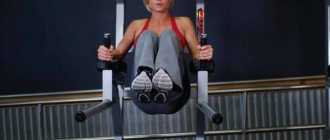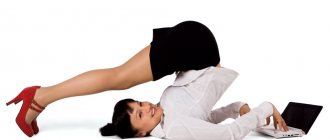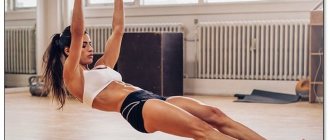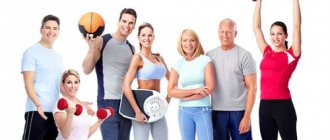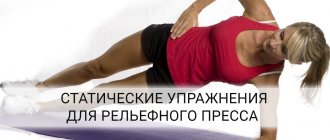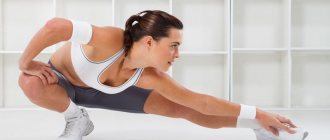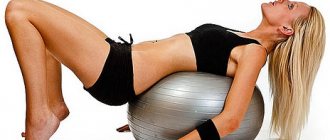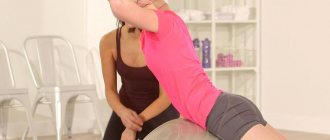Are you so overwhelmed with work in the office that you don’t have time to exercise? You have time, but you don’t have the energy or desire to get ready and go to the gym? But at the same time, the whole body is simply screaming about the need for physical activity? Don't be upset!
There are great exercises that don't require special machines or equipment or too much space. And many of them can be performed while sitting at your desk. Besides, you won't even attract much attention from your colleagues and other people who are around you.
Press while sitting
In fact, you can pump up your abs while sitting, without lying on the floor in the middle of the office. To do this, you need to sit up straight, straighten your back, tense your buttock muscles, take a deep breath and sharply draw in your stomach as you exhale. Repeat this about 50 times. There is no need to hold your breath. It is the abdominal muscles that work, not the diaphragm. The oblique abdominal muscles can be trained by bending to the sides, also in a sitting position. For greater effect, fold your hands into a lock at the back of your head, spreading your elbows to the sides.
» />
Toe raises
This is an ideal exercise to accelerate blood flow through the vessels after sitting in one place for a long time without moving. It also has a good effect on the work and tone of the calf muscles and helps improve balance. Well, who wouldn't want to show off sexy, toned calves in high heels?
All you need to do is stand behind the chair, holding the back of the chair with your hands (or near the wall, holding on to it) and slowly rise up onto your toes, then carefully lower your heels to the floor. Repeat this 10-20 times to start. Gradually the load can be increased. In fact, this exercise can be done while sitting at your desk while you work. This will be less effective, but will also bring positive results, preventing the blood from stagnating.
» />
Pumping up the triceps
Another exercise you can do while sitting at your desk will help strengthen your triceps. In general, it is good to use dumbbells for this. But they can be replaced with bottles of water or, for example, heavy books, or other heavy objects that are found on the table or in its drawers. In general, you can simply use the weight of your body, but at the same time keeping your arms in good tension.
Sitting on a chair, move your body forward as much as possible, forearms parallel to the floor, arms vertically with palms facing the body. On the count of one, straighten your arms with the weights, stretching them back, and on the count of two, return them to the starting position. Repeat 10-20 times. Muscle imbalance leads to frequent arm pain and minor injuries, so you need to train not only your biceps, but also your triceps.
» />
Wall sitting
Sitting against a wall will help tone the muscles in your legs and thighs, making them stronger and more resilient. At first this may seem unrealistic, but over time practice will prove that this is not so, and each movement will become easier and easier. This exercise is also good because it gives you the opportunity to break away from the computer and get up from your chair, giving your eyes and butt a rest.
So, any office must have walls, at least four. At least half of one of them should not be filled with furniture. You need to go to this wall and imitate sitting on a chair next to it. To do this, press your back tightly against the wall and put your legs further forward. Lowering your pelvis down along the wall, reach a sitting position: your back is straight, your legs are bent at the knees at a right angle. Remain in this position for as long as possible. Then get up and continue working.
» />
Exercises in the office - exercises in pictures
Another option for isometric gymnastics that you can perform in the office without getting up from your chair, and you can do it without others noticing.
OK it's all over Now! Get busy! And I would be grateful if you share these exercises on social networks!
Strengthening your abdominal muscles improves your posture. Even if you spend a lot of time at your desk, you can also strengthen and tone your abdominal muscles by doing appropriate chair abdominal exercises. It is believed that doing press exercises on a chair every day is completely acceptable and safe. However, you should consult your doctor before starting a new exercise regimen, especially if you have recently suffered an injury or have a chronic illness.
Squats
Also a good reason to spend a little time away from the computer. Squats improve mobility, improve balance, and are beneficial to the entire body because they work the majority of all muscles. Not only the muscles of the legs, calves, thighs and buttocks are pumped, but also the muscles of the back, abs and shoulders, since they are all involved in the process.
You need to stand straight in a comfortable position, place your feet at a comfortable width, then lower your pelvis down, moving your body a little forward to maintain balance. Imagine that you are sitting on a chair that is behind you, do not push your knees forward, keep your legs as perpendicular to the floor as possible. The pelvis drops to the level of the knees. The trick is to keep your back perfectly straight, without arching it or bending forward.
If the office has a strict dress code that forces you to wear tight, knee-length skirts, don't think that this will save you from doing the exercise. You can do mini squats, lowering your hips no lower than your knees, holding this position for a few seconds, and then rising.
» />
We continue our home workout with a chair
7.Place a chair against the wall. Lie down on the mat, rest one foot on the edge of the chair, lift the other up to create a 90-degree angle. Your arms are positioned along your body. While in this position, lift your pelvis off the mat and lift it up. The movement occurs due to the buttocks (butt) and the support of the leg on the chair, while the position of the hips does not change. We dropped, as soon as we touched the floor, a new rise immediately began. Just 12-15 repetitions on one leg, then change position.
8. The final exercise of our program with a chair. Lie down on the floor. Extend your legs and place them on the edge of the chair. Hands behind your head, shoulder blades slightly off the floor. The lower back rests completely on the mat. Start moving your legs. Move them apart from the chair and begin twisting. Elbows and knees move towards each other. The shoulder blades and pelvis come off the floor. Do not lift your back off the mat. We come back, without putting our feet on the chair. This counts as one repetition. 12-15 repetitions.
As you can see, such physical exercises can be performed with a simple home chair. This saves time and money, and the complete absence of burdens when performing the complex. But with such simple exercises you will tone your muscles and pump up your problem areas, and after several weeks of training with a chair you will look much better. Leave comments and share with friends. If you have any difficulties, write, I will be glad to answer your questions. Look at other sets of exercises for girls on the map. Best regards, Sergei.
Did you like the article? Share with your friends
All physical exercises can be divided depending on the position in which they are performed. The body position for the exercise is not chosen randomly. It depends on which muscles are being worked on. Naturally, it is better to pump up your abs while lying down, although there are exercises for the abs that can be performed in other positions. It is often necessary that no other muscles be involved in the exercise other than those being worked on. The correct choice of position for a particular exercise can significantly increase its effectiveness.
In addition, there are situations when a person, due to health problems, cannot perform exercises as everyone else does. In this case, you can perform, for example, exercises in a sitting position. This will provide the necessary mobility and help maintain muscle tone. Seated exercises allow you to work the muscles of the back, abs, and arms. If you wish, you can choose sitting exercises that will strengthen the muscles of your legs, thighs and buttocks. Exercises in a sitting position can be very diverse and based on them it is quite possible to create a full-fledged complex for effective training. This is especially true since you can sit either on the floor or on a chair, or on another high surface, which allows you to vary the load and change exercises in a sitting position.
Wall push-ups
This last simple exercise, which can easily be done in the office, works the chest, back and shoulder muscles, as well as the triceps. Wall push-ups may not seem so difficult, but there are also rules here, and only proper execution of the exercise can lead to maximum results without any injuries.
So, stand facing the wall, place your palms on the wall at chest level, move your feet back a little until your heels no longer touch the floor.
We perform push-ups: inhale as you approach the wall, exhale as you push away from it. Firstly, there should be a perfectly straight line from the top of your head to your heels: never stick your heel out backwards or push your pelvis forward. Perfectly straight spine! Secondly, never lock your elbows when you straighten your arms, this can lead to injury.
» />
Well, that's the whole set of office exercises. They don't require much time, or special equipment, or even space. Everything is very simple and has several advantages: firstly, it provides the necessary physical activity in the absence of the opportunity to visit the gym, secondly, it warms up the muscles of the whole body, sore from sitting at the table for a long time, and thirdly, it simply provides an opportunity to escape and relax. rest from work.
- Weight loss
miridei.com
Complex for neck muscles
Do you remember how physical education lessons began at school? That's right, with a warm-up for the neck. It is this part of the body that suffers the most from office work. Constantly sitting in front of monitors causes stiffness, tension and pain in the neck. These exercises are ideal for warming up at the beginning of a workout and as a way to relieve stress at the end of the working day. The complex is performed in three approaches .
- Tilt the head forward and backward - 10 times
Goal: relieve muscle tension in the sternoclavicular, splenius, and subcutaneous muscles of the neck.
While standing, tilt your head forward and backward alternately. They should be as deep as possible. Between bends, stop in the starting position. Try not to make sudden movements, do not strain your muscles.
- Head tilts to the sides - 10 times
Goal: relieve tension in the sternoclavicular, mastoid, anterior, middle and posterior scalene muscles of the neck.
In a standing position, first tilt your head to the right, trying to achieve maximum stretching. Without pausing, tilt your head to the left. Don't raise your shoulders.
- Neck rotations - 10 times
Goal: to warm up the muscles and relieve their stiffness.
In a standing position, perform neck rotations, alternating clockwise and counterclockwise rotations. Exercises should be performed smoothly.
- Static back bends of the neck - counting up to 10
Goal: training the sternoclavicular and splenius muscles of the head.
Stretch your arms back, clasping your palms together and resting the back of your head against it. Straining only the muscles of the neck, press on the palms, counting to 10. Perform the exercise smoothly, trying not to involve other muscle groups.
- Static forward neck bends - counting up to 10
Goal: training the subcutaneous muscle of the neck.
Place your forehead on your palms, clasped together. Slowly tilt your head, trying to overcome the obstacle, tensing exclusively the muscles of your neck. Perform the exercise on a count of 10.
- Static neck bends to the sides - counting up to 10
Goal: training the sternoclavicular muscle.
Place your right hand on your right temple. Left - fixes the position of the right one. On the count of 10, press down on your palm using only your neck muscles. Repeat the same techniques with your left hand and temple.
- Static bending of the neck to the sides with emphasis on the chin - counting up to 10
Goal: improving the tone of the neck muscles.
Place your chin in the base of the palm of your right hand, press hard on your hand, tilting your head to the right, tensing only the muscles of the cervical spine. Perform the exercise on a count of 10, repeat with bends to the left.
Workout with a cup of coffee
Often, dumbbells, jump ropes, and weights are used as equipment during exercises. But you won’t find all this in the office, but you can always take a coffee break and use the cup as sports equipment. The main thing is to drink the contents in advance and not get burned. The complex is performed in three approaches with two minutes of rest between each .
- Squats - 10 times
Goal: improving muscle tone of the arms and legs.
Grasp the handle of the cup with both hands, extending them in front of you parallel to the floor. Perform ten squats without bending your arms, with your back slightly tilted forward.
- Lunges - 10 times
Goal: improving the tone of the muscles of the legs, buttocks, forearm and hand.
The right hand is on the belt, the left half-bent holds the cup. Take a wide step forward with your left leg, keeping your torso straight, your knee bent, a right angle is formed between your thigh and shin, and the center of gravity is transferred to your forward leg. At the same time, the left arm fully straightens. After returning to the starting position, change legs and arms.
- Swinging the leg to the sides - 10 times
Goal: tone the inner surface of the leg.
The left hand is on the belt, the right hand is half-bent, holding the cup. Feet shoulder width apart. Swing your left leg, trying to achieve maximum muscle stretch. The center of gravity is transferred to the left leg. After returning to the starting position, change arms and legs.
- Raising a cup - 20 times
Goal: improving arm muscle tone
The right arm is raised and bent at the elbow, holding the cup. From the starting position, raise your arm above your head, straightening it as much as possible. After this, change hands.
- Swing your arms to the sides - 20 times
Goal: relieve tension and stiffness in the shoulder girdle.
The left palm is located in the solar plexus area. The right hand with the cup is straight, extended forward. Without bending or tilting your arm, swing to the side. After returning to the starting position, change the position of your hands.
- Hold the leg bent at the knee for a count of 20
Goal: strengthen the muscles of the thighs and buttocks.
The left arm is bent at the elbow and holds the cup. The right leg is raised, bent at the knee, the thigh is parallel to the floor. Hold your leg in this position for a count of 20. After that, change your leg.
1trenirovka.com
Physiotherapy. I had pain in my spine, my arms went numb, and I felt dizzy. Doctors prescribed therapeutic exercises. I treated this recommendation with irony, but decided to try it, I was already tired of the pills. Surprise awaited me after 10 sessions of exercise therapy. My health has improved. I continued to do gymnastics at home for another three months, then laziness and good health took their toll. At first I started doing exercises not every day, and then I gave up completely. But as soon as the symptoms of the disease return, I immediately begin to do life-saving exercises. It is very light but effective. I recommend. This type of exercise helps me. The doctors were right.
A set of exercises. All gymnastics are performed while sitting on a chair.
01. Hands on knees. We clench our fists with slight tension. (15-20 times); 02. From the side, raise your hand up, behind your head, to reach the opposite ear. Then to the starting position. Same with the other hand. (10 times); 03. Sliding our hands along the back legs of the chair, we lean first to one side, then to the other, smoothly, not sharply, as much as possible. (10 times); 04. Turn your body back. Grasp the back of the chair with both hands on one side, then place your hands on your knees. And on the other hand, as far as possible, we turn the body. (10 times); 05. Tilt your head to one shoulder and to the other. Gently, not sharply, stretch the neck muscles. (10 times); 06. Spread your arms to the sides - inhale. As you exhale, hug yourself tighter. (15 times); 07. Hands to shoulders. Circular movements forward and backward. (10 times); 08. Brushes in a lock. Stretch forward from yourself, straightening your arms at the elbows. Then back to yourself, relax. (15-20 times); 09. Brushes in the castle. We press first on one hand, then on the other, straightening our fingers. (15-20 times); 10. Turn the fingers in the lock, first with one side towards you, then with the other with a little tension. (15-20 times); Exercises with a gymnastic stick. 01. Place a stick between your feet. Stretch your entire body forward as far as possible and back to the starting position. (10-15 times); 02. Circular movements in one direction and the other, as far as possible, bending with the whole body as much as possible. (10-15 times); 03. Take the stick by the edges. Lift up - inhale. Lower – exhale (10 times); 04. Circular movements. 3 laps forward away from you and 3 laps back toward you. We alternate (5 times); 05. Move the stick to the side and back, turn the body along the direction of the stick. Then we put her on our laps. And turn in the other direction. (10 times); 06. Take the stick in the middle with outstretched arms in front of you. We twist it one way and the other with a little tension. (15-20 times); 07. Take the stick vertically in one hand. We move it to the side and back, turning the body along the direction of the stick. In front of you, pass to the other hand and turn in the other direction. (10 times); 08. Take the stick by the edges, slightly tilting the body forward, imitating kayaking. 09. Raise the stick up - inhale. As you exhale, lift one shoulder. Then up - inhale over the other shoulder. 10. Stick behind your back. Take it closer to the center and massage your back from bottom to top. (15-20 times). 11. Take the stick diagonally behind your back. Rub your back like a washcloth on one side and the other. 12. Place the stick on your knees. We roll it forward and back with our palms, the backs of our hands, outer and inner. (10-15 times); 13. Raise the stick up - inhale. Lower - exhale. (10 times).
www.liveinternet.ru
Chair exercise. What, why and why?
Tell me in spirit, where does the Motherland begin to create an elastic butt? Many girls are sure that they start with squats, and therefore, when they first come to the gym, they begin to “rape” their buttocks with a variety of exercises. It would seem logical that you need to work the target muscle group. But the secret that few young ladies know is that “zhenya” needs to begin to be built by developing the hips and strengthening the knees, and here’s why... The gluteal muscles are a hardy and strong muscle group that loves, for the most part, volume power load, i.e. they cannot be carried with light weight 7-1
0 reps in
2-3
sets.
Light weight is considered to 1/2
of a woman's body weight.
For example, if a girl’s natural weight is 50 kg, the weight of the barbell with weights will be 25 kg. For a newbie girl who just joined the gym and has never squatted before, 25
is a fairly decent weight. But that’s not the problem! The buttocks need a lot more weight for their growth (in this case we do not take into account the position of the legs), but the knee joint already at 25 does not feel so great.
It turns out that the volumetric development of the fifth point will be restrained by the hips (usually women have weaker quadriceps and hamstring muscles than men) and knees (they begin to hurt when working with any serious weights). What to do? Give up on your goals at the very beginning of your journey? No, don’t give up, but include the chair exercise in your training.
Note:
For better assimilation of the material, all further narration will be divided into subchapters.
Muscle atlas
The exercise belongs to the static/isometric class and is aimed at working the leg muscles.
The muscle ensemble includes the following units:
- targeted – anterior thigh;
- auxiliary - hamstrings, gluteus maximus, adductors, gastrocnemius, lower back muscles, rectus abdominis.
A complete muscle atlas looks like this.
Advantages
By performing the chair exercise, you can expect to receive the following benefits:
- development of strength in the front and back of the thighs;
- increasing the endurance of the body, in particular the lower body;
- strengthening knee joints;
- ability to perform heavier squats;
- development of concentration and balance.
Execution technique
The chair is an exercise at an entry level of difficulty. The step-by-step execution technique is as follows.
Step #0.
Go to the wall and press your back tightly against it. Take a step forward, place your feet shoulder-width apart, and point your toes slightly outward. Place your hands along the body along the wall. This is your starting position.
Step #1.
Inhale and, sliding your back against the wall, lower yourself down until your thighs are parallel to the floor. Maintaining the angle in the knee joints 90
degrees, hold the static position as long as you can (at least
30
seconds). After the time has expired, return to the IP. Repeat the specified number of times.
In the picture version, all this disgrace looks like this.
In motion like this:
Variations
In addition to the standard version of the high chair, there are several variations of the exercise:
- with a dumbbell/weights in hand;
- with legs closed;
- with fitball for feet;
- on one leg.
Secrets and subtleties
To get the most out of the exercise, follow these guidelines:
- during squats, do not close your thighs, but keep them at a distance from each other;
- watch the angle in the knee joints, it should be strictly 90
degrees; - while in a standing position, rest your feet on your heels;
- the rougher the wall, the easier it is to perform the exercise;
- to reduce the load, place your hands on your knees;
- ideally, stand in a static position each time until a burning sensation occurs in the quadriceps;
- breathing technique: arbitrary, free inhalation and strong exhalation through the mouth, lips with a tube;
- numerical training parameters: number of approaches 3-5
, holding the position for
30
seconds.
We're done with the theoretical side, now let's look at some practical points.
How to develop leg strength by working out at home
Professional athletes know that mass begins with strength, i.e. muscle volumes follow after an increase in muscle strength. The chair exercise is an excellent means (for both men and women) of developing lower body strength. Research shows that isometric exercises are an excellent way to develop strength.
If your goal is to pump up/enlarge your legs (men) and buttocks (women), then you should include the chair exercise in your leg exercise routine. For a beginner it is enough to 2,5-3
months,
5
times a week, conduct home sittings in a stand, performing
4-5
approaches of
30
seconds.
Every week (ideally a new day) you need to increase the time by 5-10
seconds. The chair is especially suitable for women with weak knees who want to remove the flatness of their buttocks.
Use this exercise, and over time you will be surprised at how quickly your buttocks begin to increase in volume.
How long to do the high chair?
Despite the apparent ease of the exercise, it is very stressful for the leg muscles. At the initial stage, you are unlikely to be able to sit in one place for more than 30
seconds The American Council on Exercise has compiled the following high chair rating chart:
- men: excellent result - more than 100
seconds, good -
75-100
seconds; - women: excellent result – more than 60
seconds, good –
45-60
seconds.
Bring your gatherings to the specified values, and you are guaranteed strong legs.
Afterword
At the AB project, we try to analyze not only classic themes and movements, but also something new, not hackneyed. Today it's a chair exercise. I am sure that until now you have never done it before, and the key here is until now, because after finishing reading you will definitely include this static in your daily activity. It is so?
I hasten to say goodbye to this, see you soon!
PS:
Do you do isometric exercises? Which?
PPS:
did the project help?
Then leave a link to it in your social network status - plus 100
points for karma is guaranteed :)
With respect and gratitude, Dmitry Protasov
.
Greetings to all lovers of a healthy lifestyle and sports!
Many girls, due to their modesty and excess weight, do not want or cannot go to the gym, but want to change their appearance in the direction of losing weight. You don’t have the necessary tools at home (dumbbells, barbells), isn’t this an excuse, a way out? - There is. I offer you physical exercises with a chair. At the initial stage, this set of exercises will help your muscles get used to the load. Particularly problematic areas are the thighs, buttocks, abs, and triceps. He will discipline you, accustom you to a daily routine, and there will be room in it for training to improve your figure. If you have little experience in physical education, then you can safely start a course of physical activity.
Hidden gymnastics
In fact, inactivity is a pressing problem. Use special exercises, so-called hidden (or isometric) gymnastics .
These movements (or exercises) can be performed anytime and anywhere without attracting the attention of others.
The method of “constant hidden training and physical impact on the body,” or more simply, “gymnastics for the lazy,” is an excellent alternative to traditional physical education classes.
The main task of this method is to compensate for the lack of physical activity that most residents of large cities experience.
The effectiveness of classes depends on their frequency and regularity.
Any exercise is performed either until fatigue sets in, or as long as there is a desire and opportunity.
You can perform the exercises statically or dynamically - this does not affect the effectiveness of the training. If no one can see you, both options are good.
If you need to make the training invisible, use the static option.
Efficiency of classes
The audience is interested in how effective chair exercises are for losing weight. Experts note that the effectiveness of exercise directly depends on how often you practice. One of the main conditions is full compliance with the system, following the training scheme.
It is important not only to exercise regularly, but to maintain a special diet. As a rule, almost any diet involves severe restrictions on the daily amount of calories and an increase in the volume of fluid consumed. As a result, water comes out of the body first. This is approximately 3-4 kilograms, which are recent. Already a week after the start of dietary restrictions, a woman may notice that she wakes up with an empty stomach, and her stomach has significantly decreased. The next result of losing weight is the face. Everything unnecessary goes away, swelling subsides (again due to the release of water).
Girls note that their cheekbones stand out, their hated cheeks disappear, and their double chin disappears. Nutritionists say that getting rid of the belly and cheeks are the simplest tasks of weight loss methods, which can be solved already in the first months of losing weight.
The most inaccessible places are those areas that are the hardest to work on. These include the triceps area. This area should receive the most attention. Even with effective weight loss, it is necessary to include strength training, since without them the skin can sag significantly.
The hips and buttocks area is quite difficult to lose weight precisely because of physiological natural factors. Much depends on your body type. If a woman has a glass-shaped figure, then there is a high probability that she will be able to achieve ideal waist measurements, but her hip measurements will remain the same. In this case, all that remains is to “ennoble” the problem areas: tighten the skin, gain muscle mass, get rid of the “orange peel”.
You need to pay attention to the side area. Hanging fat deposits are a phenomenon that does not appear overnight. This is a long process that has a cumulative effect. It also takes a long time to correct this problem area of the female body.
Exercises you can do without attracting attention
- For example, when you wash your face, you can stand with your bare feet on a rubber mat with a lumpy surface - this is a good tonic procedure, since there are many biologically active points on the soles of the feet associated with internal organs. Thanks to the unevenness of the mat, a natural massage of these nerve formations occurs and the body receives an additional charge of vigor.
- When leaning over the sink, do not hunch over or bend your knees - this helps increase muscle tone.
- Walk as much as possible, do not stand passively on the escalator in the subway, but, if possible, go up and down the stairs.
- When you walk, don't slouch . Learn to walk easily and naturally, then you will get less tired.
- pull in your stomach with all your might , as if you want it to touch your spine. Count to six and relax . Do this as often as possible and you will get rid of excess fat around your waist and belly. But this exercise cannot be done immediately after eating.
- tighten your buttock muscles as much as possible . Count to six and relax. The more often you do this exercise, the faster and more graceful your silhouette will be.
- When doing household chores or walking along the work corridor, while no one is looking, alternately take four steps on your toes and four normal ones . Then four heel steps, then four regular ones . You can try it - it strengthens the ankle joint.
Hidden gymnastics by Vorobyov for those who hang out at the computer
- Sitting on a chair, your heels come off the floor with force . To increase the effect, you can press your palms on your knees. Repeat 30 - 40 times for 1 minute.
- Sitting on a chair, lift your socks off the floor, as if overcoming resistance . At the same time, the muscles of the lower leg, foot, and thigh become noticeably tense. Repeat 30 - 40 times for 1 minute, you can also do it while standing.
- tense and relax your buttocks 40 times , it is especially good to do this in transport, since in winter it is absolutely unnoticeable. Just squeeze them and relax.
- pull your stomach in with all your might , as if you want it to touch your spine. Count to six and relax . Repeat this as often as possible.
- Slide your shoulder blades back toward your spine so that your back appears flat. Repeat 30-40 times.
- Clench and unclench your fists, making great efforts to do this. So that the tension in the arm muscles reaches the triceps.
- Turn your head first to the right and then to the left 90 degrees. Repeat this at least 10 times for each side.
- firmly on the seat of the chair, raise your feet slightly above the floor . Then try to get up yourself. Slowly return to the original position. This perfectly strengthens the muscles of the shoulders and chest. While sitting, make periodic circular movements with your feet, each in turn.
anisima.ru
Steps
Start gradually
- Find a sturdy chair.
To perform abdominal exercises in a chair, you need a stable chair with a flat seat and no armrests. A dining or kitchen chair is quite suitable for this purpose. Avoid using chairs with wheels, as they are unstable and may accidentally roll out from under you.
- If you only have a chair with wheels, see if you can lock them to prevent them from spinning. Placing a chair against a wall can also help.
- Sit on the edge of a chair.
Take a moment to ensure that you are in proper posture with your shoulders back and your shoulder blades tucked together. You should sit on the bones of the hip joint, not on the tailbone.
- Your knees should be bent at approximately right angles, and your feet should be pressed to the floor. If you can't do this, then perhaps the height is inappropriate.
Get comfortable in your position and tune in to your breathing. Take a couple of minutes to breathe deeply, inhaling through your nose and exhaling through your mouth.
Press your hands firmly to the sides of your torso and thighs. Make sure your back is slightly below the back of the chair. She shouldn't cling to her.
Lean back in your chair.
Tighten your abdominal muscles and lean back until you almost touch the back of the chair. Your shoulders may hit the back of the chair, just try not to put your weight on it.
- Be sure to keep your back as straight and level as possible. Keep your shoulders back and your shoulder blades aligned with your spine.
Engage your abdominal muscles and return your body to the starting position, keeping your back straight and level. Move slowly and evenly.
- Perform 10 repetitions of the exercise, while monitoring your own breathing all the time.
Stretch your arms out to the sides so that they are parallel to the floor. This exercise can also be performed with your hands behind your head. Choose the position of your hands that is most comfortable for you.
Perform twists left and right.
Slowly rotate your torso, engaging your abdominal muscles and making sure your back remains flat and straight. The legs and hips must remain motionless during the twist. First, twist to the right, hold in this position for about three seconds, then return to the center position, and then repeat the twist to the left.
- Do three to five repetitions of the exercise on both sides.
From the same sitting position, bend your right arm at the elbow and place it behind your neck. Then extend your left arm and raise it above your head.
- Take time to tune in to your breathing and check your posture.
Bend your body to the side, not forward or backward. You should feel a stretch or tension on your left side. Bend to the side until you feel a stretch, but don't force yourself to reach further than that.
- Your movements should be slow and controlled. Hold the tension for a few seconds and then slowly return to the center position.
Bend your left elbow toward your left hip, stopping when you feel a stretch in your right side. Keep your back straight and don't sag your shoulders.
- Pay attention to the difference in sensations when tilting left and right. If you are able to bend more to one side, this may indicate uneven muscle development.
Perform 5 to 10 repetitions of the exercise in each direction, continuously engaging the torso muscles.
Introduce more complex exercises
- Sit upright on the edge of a chair.
Place your legs directly in front of you, with your feet firmly on the floor and your knees and hips closed. To perform this exercise, you need a stable chair standing on a flat surface. If your chair is wobbly, you may have difficulty completing the exercise.
- Rest your hands on the seat of the chair.
If you wish, you can even grab the edges of the chair seat to provide yourself with
greater
stability. You need to be able to get a firm grip on the chair and balance with it, so a chair with a soft seat is not the best choice for this exercise.- As you work your torso muscles, watch your breathing.
- Lift your hips off the chair, supporting yourself with your hands.
Bend your torso and lift your hips off the chair. Use your hands to lift your hips 1 to 2 inches off the chair, or as far as you can.
- Make sure your shoulders remain level and not pushed forward.
If the exercise becomes too easy for you, try starting to straighten your legs in front of you and only then raise yourself so that your hips do not touch the chair.
What are the dangers of sitting?
Persons who have sedentary work suffer from osteochondrosis.
In parallel with the increase in the number of office workers, the number of people suffering from pathologies of the musculoskeletal system is also increasing. First of all, these are degenerative-dystrophic diseases of the spine, the most famous of which is osteochondrosis. In addition, this category of people is also characterized by other diseases, in particular:
- low back pain syndrome;
- tense neck syndrome;
- glenohumeral periarthrosis syndrome;
- tunnel syndromes;
- Hoffa's disease of the knee;
- gastritis;
- inflammatory lung diseases;
- prostatitis;
- haemorrhoids;
- obesity and others.
To prevent or at least reduce the risk of developing these diseases, office employees need to maintain the correct posture during work and periodically take breaks from work, during which they ventilate the room and perform a set of simple physical exercises. This will help activate blood flow (as people say, disperse the blood), speed up metabolic processes, relax tense muscles, which will ultimately improve a person’s well-being and increase his ability to work.
Training with a chair
A chair is like an exercise machine; everyone has one at home. Therefore, do not be lazy and start training to burn fat and pump up your stagnant muscles. This chair exercise program includes static loading, jumping elements and dynamic exercises. The complex must be performed in a circular pattern. If you are already an athlete with little experience, you can perform approaches without a break. If not, then you can allow yourself 15-20 seconds of rest between exercises, but do not get carried away with a long break. Try to build up your chair exercise program at home to 5 rounds. You shouldn’t immediately chase the result, everything comes with time, the main thing is to calculate your strength. Age doesn’t matter here, dear girls and women.
If you have problems with the musculoskeletal system, suffer from heart failure, or if you are pregnant, it is better not to use this complex. For the rest of the exercises with a chair, see below and don’t be lazy.
Prepare the exercise machine, place it with its back against the wall, the chair should have four supports without armrests, the seat of the chair should be level with your knee. Prepare a sports mat, be sure to put on sports attire and sneakers - we are starting.
Types of industrial gymnastics
There are several varieties of it, among which the most relevant and in demand are physical education breaks and physical education minutes.
Each employee conducts physical education independently every 60-90 minutes. If you do not change your body position for a longer period of time, the intervertebral discs begin to experience excessive load, which will undoubtedly lead to pathological changes in them. A physical training session takes only 2-3 minutes, during which the employee performs 2-4 physical exercises.
A physical education break is an organized activity. It is carried out 1-2 times during the working day: 2-3 hours after the start of work and the same amount of time before the end of it. The duration of such a pause is 5-10 minutes, during which employees do exercises with audio accompaniment or following the recommendations of a video trainer.
In addition, each person should begin their workday by monitoring their working posture: assessing and adjusting the height of the chair, the location of the monitor and keyboard.
What to pay attention to
Before starting the exercises, you should not miss the following points:
- it is necessary to ventilate the room in which classes will take place well;
- the temperature and humidity of the air in it should not be too high (no more than 25 ° C and 70%);
- If possible, exercises should be performed near your workplace;
- It’s ideal if you select music that suits the tempo for your classes;
- Training should be carried out in comfortable, loose clothing and suitable shoes - with a heel securely fixed back, a hard sole, a comfortable last and a low, stable heel;
- it is necessary to avoid too intense exercises (they activate sweating, and you are unlikely to be able to take a shower after exercise), high-amplitude swings and generally sudden movements (doing such exercises in office clothes will not be very comfortable and is fraught with cracked seams);
- You should practice regularly – several times every day.
Exercises
The choice of exercises is huge. The program must be developed depending on the gender, age, health status, level of fatigue and general physical fitness of employees. If, while performing exercises, a person suddenly feels unwell (notes the appearance of weakness, shortness of breath, dizziness or headache), he should take a break to rest, reduce the number of repetitions, and also consult a doctor.
We bring to your attention some options for industrial gymnastics exercises:
- Starting position (hereinafter IP): sitting on a chair, holding a small ball between your knees. Squeeze it as much as possible and maintain this position for as long as your muscles allow. 1 repetition is enough.
- IP: standing straight, feet shoulder-width apart, muscles of the anterior abdominal wall tense. “One” - press the heel of your left foot into the floor, hold it in this position for 7-10 seconds. “Two” - IP. Change leg. Number of repetitions – 10.
- IP: sitting on the edge of a chair, leaning forward, hands on the table. “One” - raise your buttocks above the chair, hold for 2-4 seconds. “Two” - return to IP. The number of repetitions is 15-20 times.
- IP: sitting on the edge of a chair, back straight, clasp the armrests with your hands. Tightening the muscles of your arms and chest, squeezing your elbows, pull the armrests towards you. The number of repetitions is 20 times. If your armrests are fragile, do not perform the exercise.
- IP: sitting on a chair. On the count of “one” – straighten your legs, pull your toes forward; raise your hands and pull them up. On the count of “two” - return to IP. Number of repetitions – 3 times.
- IP: standing behind a chair, placing your hands on its back. On the count of “one”, take one leg back and spread your arms to the sides. On the count of “two” - return to IP. On the count of three, move your other leg back and also spread your arms. “Four” - again IP. Number of repetitions – 4 times.
- IP: the same as in exercise 6. “One” - move your left leg to the side, raise your right arm. “Two” - return to IP. “Three, four” - do the same with opposite limbs. Repeat a total of 12 times.
- IP: sitting on a chair, legs and arms extended parallel to the floor. Bend your torso to the left and right, while spreading your arms. Perform 10 times in each direction.
- IP: sitting on a chair, legs extended parallel to the floor, hands on the belt. Pull your socks towards you one at a time. The number of repetitions is 12 times.
- IP: standing straight, arms extended forward. “One” - spread your arms out to the sides as far as possible. “Two” - return to IP. Number of repetitions – 10 times.
- IP: sitting on a chair, back straight, shoulders apart. As you inhale, tighten your buttocks as much as possible, and as you exhale, pull in your stomach as much as possible. Do 20-30 repetitions. Perform the exercise rhythmically, do not hold your breath.
- IP: sitting on a chair, knees together, bent at a right angle, palms resting on the chair behind your back. Keeping your back straight, on the count of “one”, raise your legs bent at the knees, on the count of “two” - return to the IP. The number of repetitions is 15-30 times.
A set of exercises for working out in the workplace
Active physical exercise or just exercise is, in most cases, an unaffordable luxury. Only the lucky owners of a separate office or free time can do them in the workplace. This is why knowing the basics of office gymnastics may come in handy. This is a comprehensive tool for training all muscles in the workplace, designed in such a way that all your actions are as invisible as possible to others. In other words, this is a kind of fitness for the office. In ordinary life, such exercises are used for warming up, but they can easily replace the main workout. The main thing is to correctly distribute the load and do everything as consistently as possible.
Such static complexes are also called isometric, as well as office yoga. In principle, this is not far from the truth, because they are all designed for full concentration, low speed and even breathing (as opposed to cardio exercise).
Exercises in the office on a chair
Most isometric exercises for the office are designed so that you can do them while sitting, that is, right at your workplace. You don't have to spend hours a day working every muscle in your body. Just make it a habit to do simple exercises for your abs, arm muscles or back several times a day. For example, half an hour before lunch, begin to actively suck in your stomach - this will help both remove your tummy and slightly reduce the volume of your stomach (which means you will eat a little less than usual). Have you worked for 2 hours without taking your eyes off the monitor? Stretch your neck and stretch your back thoroughly. Did something fall off the table? Lift it up by squatting nicely a few times. Thus, you will not need to allocate separate time for training at all - it will take place without interruption from your work process.
5 exercises you can do at work
On the Internet you can find a lot of different complexes that can be performed simply at your desk and which can completely replace classes in the gym. Their basis is fairly simple isometric exercises that can be done by a person with any physical characteristics.
Exercise 1
The exercise is performed while sitting. The back is absolutely straight, the shoulders are lowered and relaxed. We slowly straighten our neck (but don’t throw it back), hold in this position for 2 seconds and lower it down again. Repeat 5-10 times.
Exercise 2
The exercise is performed while sitting. The back is straight, legs are on the floor at an angle of 90 degrees. We raise our shoulders up, slowly move them back, bringing our shoulder blades together. Lower your shoulders down and return to the starting position. Repeat 10-15 times.
Exercise 3
This exercise can be done standing or sitting. We join our hands in a lock, raise them up and stretch. At the highest point, we linger for 1-2 seconds, then carefully return to the starting position. Repeat 5 times.
Exercise 4
The exercise can be performed standing or sitting. We stretch our arms in front of us, quickly open and close our hands. Try to do the exercise as energetically as possible. Repeat 8-10 times.
Exercise 5
To perform the exercise, you need to sit on the edge of a chair with a straight back. Place your feet together, close your knees. Straighten your right leg (note: we pull the toe towards you), put it in place. We do the same movement with our left foot. Repeat 20 times on each leg.
But these are not all the exercises that can be done at the workplace. Raising your legs in a sitting position, squats, lifting your body with outstretched arms from a chair, bending, bodyflex - these are all your friends and helpers in the fight for an ideal body.
If you want to improve your body a little and lose weight, take every opportunity to move as much as possible. Have you been sitting at the computer for a bit? Do a little exercise, tidy up your desk, or just take a walk up the stairs - this will help compensate for the lack of movement without causing you unnecessary hassle or difficulty.
In any case, remember that a slim and beautiful body is daily work on yourself, which you can do “on the job.”
1000sovetov.ru
We are constantly looking for excuses for not exercising. One of them is that we don't have time for this because of work. Now you will have one less excuse, because the complex that we will show you today can be done even at your desk!
It includes 9 exercises that stretch the muscles, tone them and help avoid unpleasant back pain. The exercises work every part of the back, starting at the top and ending with the lower back. To this complex you can also add the same set of exercises for the neck, which you can find here.
Shrugs
This exercise works the upper back. Sit up straight and place both feet on the floor. The arms should hang along the body. Raise your shoulders toward your ears while keeping your neck straight. Pause for a moment and lower your shoulders back. Repeat several times.
Reduction of the shoulder blades
Sit upright with your feet on the floor and your arms extended along your body. Squeeze your shoulder blades together without lifting your shoulders. Pause for a second and pull your shoulders forward. This will stretch your shoulder girdle in the opposite direction. Repeat the exercise several times at a slow pace.
Shoulder rotations
Sit upright with your feet on the floor. Place your hands on your shoulders. Rotate forward a few times as if you were swimming. Repeat several times and do the same in the opposite direction.
Back crunches
Sit upright on the edge of a chair with both feet on the floor. Your knees should be parallel to each other. Place your hands behind your head and twist your torso to the right and then to the left. Repeat several times.
Lumbar arches
Sit upright on the edge of a chair with your feet flat on the floor and your hands behind your head. Arch your back and look at the ceiling. The neck, shoulders and head should go as far back as possible, and the middle of the back should go forward. Repeat several times.
Seated Forward Fold
Sit up straight with both feet on the floor. Bring your knees together and lean forward, resting your chest on them. Avoid rounding your back. You can help yourself a little by holding your shins with your hands. Stay in this position for as long as possible and return to the starting position. Repeat several times.
Side bends
Sit on the edge of a chair and place both feet on the floor. Keep your knees parallel to each other. Place both hands behind your head and tilt your torso to the left. Return to the starting position and tilt it to the right. Do not lean your back forward or backward. Repeat several times.
Cat-cow pose (Marjariasana-bitilasana)
Sit on the edge of a chair and place both feet on the floor. Your knees should not touch; place your hands on your knees. Extend the middle of your back forward, trying not to help yourself with your pelvis and shoulders. Then, round your back and stretch it back. Repeat several times at different paces.
lifehacker.ru
Details Healthy lifestyle Physical education and gymnastics
For most office workers (and freelancers working from home), being at a computer (desk) desk for an average of 6-10 hours a day is part of their normal life. We all know that such an amount of time spent sitting at a computer is not beneficial for the body and the organism as a whole.
It can lead to back pain (most people forget to watch their posture), eye strain, the development of hemorrhoids and other equally pleasant consequences.
The life of an office worker is subject to a strict schedule, in which, in addition to meetings, meetings, the incessant clatter of a keyboard and debriefing on the “carpet” in the management’s office. At the same time, performance indicators do not always satisfy the employee.
You get tired in completely different places: your shoulders become “wooden”, your lower back aches, your spine experiences enormous overload from the “wheel-over” pose, your neck becomes numb, and your eyes staring at the monitor for several hours is a completely different story. The body asks for help, and the best help is light office gymnastics.
How to make sure that working in an office on a computer is not a “strength test” for your body? There are several rules that, if followed, will improve your posture and maintain health.
Workplace ergonomics and proper posture
Before moving on to considering sets of exercises, it would be useful to remind you of the rules of landing.
Firstly, the chair itself (office chair) should be comfortable and match the desk in height and dimensions.
Secondly, posture. The back is straight, the shoulders are straightened and pulled back a little. The top of the monitor should be at eye level. If you now have to tilt your head down or up, then the height of the screen needs to be changed. Make sure your wrists are not resting on the keyboard or mouse pad (unless you have a special pad with a wrist pad). This will help avoid the occurrence of carpal tunnel syndrome (all office workers are at risk for this disease). Your legs should be bent so that your knees are slightly higher than your hips. The feet are placed on the floor or on a low special footstool.
Any workout, including office training, should begin with a warm-up. The ideal option is to go up and down two or three floors using the stairs. It's good to do this every hour or two. You will immediately “wake up” the circulatory system, which is sleepy from a sitting position. And at the same time, you’ll take a break from the hustle and bustle of work for a couple of minutes.
The exercises below will help you get rid of the feeling of stiffness and relieve fatigue of “overstayed” muscles.
Neck
The neck is not only the spine and muscles, it is also the main highway that supplies nutrients to the brain and removes its waste products. Overstrain of the neck muscles leads to impaired blood flow, which means there will be problems with the delivery of fresh blood rich in oxygen and nutrients.
- Place your hands on the back of your head, palms down, lower your head so that your chin touches your sternum, gently pull your head down with your hands, hold in this position for a few seconds, feel the stretch in the muscles of the back of your neck.
- To stretch your neck muscles, slowly tilt your head back and forth, from side to side, and turn right and left. These simple exercises can be done any time you feel like you need to relieve fatigue and tension. Afterwards, you can perform head rotations, stretching your neck. First, rotate in a circle in one direction, then in the other direction.
Attention! Never do circular rotations with your head without first “warming up” your muscles! This can cause damage to the joints in the neck. If doctors have discovered that you have cervicothoracic osteochondrosis or a herniated disc in the cervical spine, limit yourself to moving your head forward and down; moving your head back is contraindicated.
Arms and shoulders
There are many stretching exercises for your arms and shoulders that you can do without getting up from your chair. First of all, these are all kinds of stretching.
- Clasp your hands in front of you, and then raise them above your head, straightening your elbows and turning your palms up.
- Lower and raise your shoulders, trying to put stress on your muscles, forcefully pulling your head into your shoulders as you lift them, and lowering them, aiming for the floor.
- Make circular rotations with your shoulders: 10 times forward, 10 times back. This will help relieve tension. If you are not very well physically prepared, then this exercise may cause you even slight pain at first. But don't worry: once your muscles warm up, everything will get better.
- Another good exercise is the push-up exercise. Place your hands on the table (on your sides, each approximately shoulder-width apart from your body) and arch as if twisting: first tilt one shoulder towards the opposite arm, then the other. Using springy movements, try to bring your shoulders as close to the table as possible.
Wrists
- Rotate your hands around your wrists regularly (it is advisable to do the exercise once an hour): 10 times in one direction, then 10 times in the other. If you have to type a lot on the keyboard or work with the mouse, then such rotations will be a good prevention against carpal tunnel syndrome.
Back
- Place your hands on your belt. Take turns turning your body left and right. Turning to one side, spread your arms so as to bring your shoulder blades together behind your back. When turning to the other, bring your arms together in front of you, as if hugging yourself. Repeat this exercise 6-8 times.
- In the starting position, standing, feet shoulder-width apart, hands on the waist, tilt the body to the right and left, forward and slightly back. Make sure your back remains straight during these movements. Perform 10 bends in each direction. You can also perform several rotational movements of the pelvis clockwise and counterclockwise.
- With a simultaneous sharp movement, raise your right hand all the way up, your left hand down and perform several jerks with your arms while simultaneously bending your back. Then change hands.
- Stand up, put your hands on your belt. Pull your elbows back so as to bring your shoulder blades together as much as possible. Return to the starting position. Repeat this exercise 8-10 times.
- Lower your arms down and raise your shoulders as high as possible. Repeat 8-10 times.
Press
- Sit on a chair. Straighten your back, straighten your shoulders and tighten your buttocks a little. Take a deep breath and as you exhale, draw in your stomach as much as you can. Perform at least 50 such retractions. The exercise should be performed precisely by tensing the abdominal muscles. Make sure that the diaphragm does not rise at all. It is very important to inhale and exhale rhythmically, so do not hold your breath.
- For the lower abdominals there is the following exercise. While sitting, place your hands slightly behind you, palms forward. Bring your knees together. As you exhale, raise your bent legs slightly, remembering to keep your back straight. Do at least 30 approaches.
Muscles of the chest
Have you noticed that over time your posture becomes slouched, with your upper body leaning over the keyboard? If yes, as soon as you notice, do the following exercise.
- Sit on the edge of a chair, straighten your back and clasp your arms around the armrests of the chair so that your elbows and hands are on their outer surface. Now gently squeeze your elbows, trying to pull the armrests towards you. Just don't overdo it, otherwise you'll have to answer for a broken chair. Do 15-20 repetitions of this exercise, holding the tension for 5-6 seconds.
Buttocks
- Sit on the very edge of the chair and lean forward slightly. You can place your hands on the table in front of you, but do not put all your weight on them. Squeeze your buttock muscles and lift yourself just a few millimeters above the chair. Hold this position for 2-3 seconds and lower yourself into place. Perform 12–15 repetitions.
Anterior thighs
- Sit on the edge of a chair and place your feet together, pressing your knees together. The back must be straight. Alternately straighten your left and right knees, pulling your toes towards you. Perform the exercise until a slight burning sensation occurs in the muscles.
If this exercise is too easy for you, straighten both legs at once, remembering to keep your knees together. This option also allows you to use your abdominal and back muscles.
Inner thighs
- To work them out, it’s very good to use a small inflatable ball. Simply hold it between your knees and squeeze your legs rhythmically until your muscles become tired. If you don't have a ball at hand, use your fists as resistance.
Outer thighs
- This is where stubborn “breeches” are formed. While sitting, press your knees together. Place your hands on the chair on both sides, at mid-thigh level. Overcoming the resistance of your hands, press on them, straining your muscles with all your might for 5–7 seconds, then relax. Repeat at least 20 times.
Back of thighs
- Place your feet shoulder-width apart under the table. If you are wearing high heels, it is better to take them off. Remember to straighten your back and tighten your abdominal muscles. Alternately press the heel of your right and left legs into the floor, holding the tension for 5-7 seconds. Repeat the exercise 10 times with each leg.
Caviar
- Stretch your calf muscles as follows: without getting up from your chair, place your feet on your toes (so that you can feel the muscle tension). Keep them in this position until you feel some fatigue (don't wait for discomfort!). Relax. After 10 minutes, repeat the exercise again. And so on for about an hour. This exercise is a great calf workout. It also helps prevent the formation of blood clots in the vessels in the legs (the problem with veins in the legs is quite common among computer users).
Ankles
- Make rotational movements with your feet: as in the exercise for the wrists - first in one direction, then in the other. 3 times. This helps improve blood circulation in the legs and relieves itching (tingling, “pins and needles” that can occur from poor circulation).
Breathing exercises
- Standing straight with your arms down, take a deep breath through your nose and at the same time raise your arms to the sides, and as you exhale, slightly tilt your body forward and lower your arms down through your sides.
- Take a few deep breaths. To further force your abdominal muscles to work, pull in your stomach and stay in this position for a few seconds after inhaling. As you exhale, relax. Repeat several times.
As you can see, nothing complicated. When you have a free minute, do these simple exercises. Your health will thank you.
zdravnica.net
Exercise for the eyes
If you spend most of your working day at the computer or reading/writing papers, this can lead to vision problems. When the eyes become overtired, the letters on the monitor or paper begin to double, pain and burning occurs in the eyes, they water and turn red. Even if the monitor is positioned correctly relative to the eyes and there is good lighting, the eyes simply need to take breaks from working. Ideally, they should last 10-15 minutes per hour. Alas, in most cases this is impossible, but it is not difficult to allocate 3-5 minutes per hour for special eye exercises. They will help relax overstrained muscles and relieve tension. You can perform them right at your workplace.
So you should:
- periodically (every 60-120 minutes) switch vision from close to far - just look into the distance for 5-7 minutes;
- close your eyes as much as possible, then open your eyes wide; repeat 10 times;
- move your eyes up/down, left/right, rotate them clockwise and counterclockwise; repeat each movement 10 times;
- bring your eyes to your nose (try to look at your own bridge of the nose), relax your eyes; repeat 10 times.
What muscles can be pumped?
You can even train at your workplace during your lunch break. The complex allows you to work out the following muscles:
For noticeable muscle development and weight loss, it is recommended to approach the process comprehensively.
The following recommendations must be followed:
- The duration of classes is set independently. The optimal duration of classes is 15-20 minutes;
- Exercises for different muscle groups should be present in each complex;
- Perform each technique in several approaches;
- Take a 1 minute break between sets.
- It is not recommended to exercise until pain appears. Overexertion of muscles can lead to the inability to start training the next day.
While in the office, before performing exercises, you should warm up your body using simple manipulations:
- rub your hands and fingers;
- stretch the upper limbs up and to the sides;
- straighten your back, tensing your muscles;
- stretch;
- move your legs while sitting;
- walk around the office.
Exercises for the lower extremities of the body can be performed during the work process.
